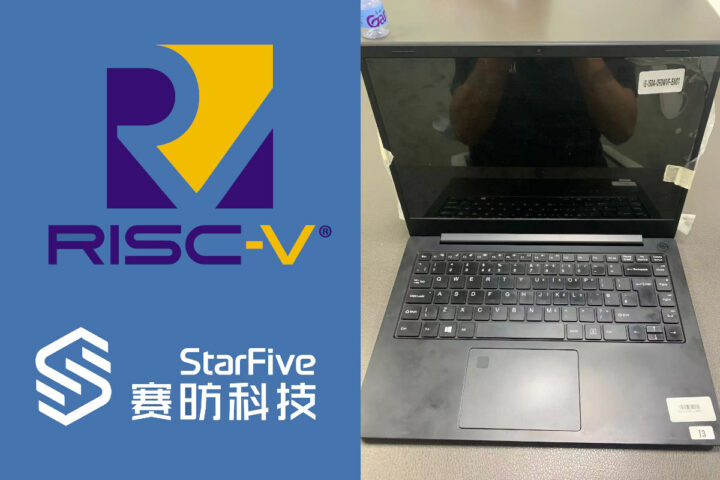Mark Himelstein, Chief Technology Officer, RISC-V International, and Dr. Philipp Tomsich, Chief Technologist & Founder, VRULL GmbH hinted that we may see a RISC-V laptop in 2022 in a presentation entitled “From Technology to Product – Maturing the RISC-V Ecosystem” with one of the slides showing what could be a RISC-V laptop prototype and The Register suspected it might come from the Institute of Software at the Chinese Academy of Sciences (ISCAS) since it was planning to build 2,000 RISC-V laptops by the end of 2022.
But there’s at least one more potential RISC-V laptop project coming our way with StarFive asking users to fill out a survey about a laptop, mini PC, or development board/SBC based on a RISC-V SoC with performance comparable to Rockchip RK3588 or MediaTek MT8192 octa-core Cortex-A76/Cortex-A55 processors.

The hardware and software specifications of the device will depend on the answers to the survey. First, it’s not sure we’ll get a RISC-V laptop since respondents will first be asked for the type of product, so we may end up with a fairly powerful RISC-V mini PC or/and SBC first instead.
You’ll also be asked for your use case, preferred Linux operating system (Ubuntu, Debian, Fedora, others), desktop environment, as well as software packages you may need such as LibreOffice, Chromium or Firefox browsers, GIMP, Thunderbird, and so on. As a side note, they’ll select 5 winners from the respondents and send them on VisionFive RISC-V SBC with the results announced sometime in July on RVSpace community. If you don’t need to enter the draw, you do not need to leave your name and email to complete the survey.
It will likely take a lot of time before such hardware can be developed, and if StarFive is about the complete the design of such a powerful RISC-V processor (which has not been formally announced), the earliest would probably be H2 2023 before getting a somewhat usable RISC-V Linux laptop or mini PC. It should take even longer if the design of the processor is in its early stage.

Jean-Luc started CNX Software in 2010 as a part-time endeavor, before quitting his job as a software engineering manager, and starting to write daily news, and reviews full time later in 2011.
Support CNX Software! Donate via cryptocurrencies, become a Patron on Patreon, or purchase goods on Amazon or Aliexpress





Thanks for the survey, but it is missing some inputs regarding hardware characteristics: when I buy a laptop, I expect it to have user replaceable RAM, a NVME, M.2 or SATA slot and two miniPCIe slots to choose my Wi-Fi card (antennas should support 2.4, 5 and 6GHz bands), and to install a LTE modem.
Having an optional smart card reader, an ethernet port are a plus, and my crazy (and most probably not popular) wish is to have a DB9 RS.232 port.
Your expectation’s to high. A suggestion: buy used business laptop, like HP Elitebook 820, Thinkpad X series, or Latitude 7 series. It have what you need, minus RS.232.
It is exciting to see RISC-V beginning to get to consumer electronics, and something with these specs would be decent.
I’m hoping that the software rebasing – from kernel upwards – is moving forward well : that’s the huge hurdle really.
I’m willing (open source) RISC-V on, I really am.
Rk3588 performance, but what GPU ?
PowerVR, most probably.
I think StarFive is working with Vivante for the JH7110 processor, so it might be a Vivante GPU on that one too.
I hope the gpu will not kill the device efficiency
How about a module with laptop carrier, miniPC carrier, etc.
hhmm… something like EOMA68?
I have little hope for EOMA68 at this stage.
A RISC-V card for MNT Reform is more likely
It seems that the survey was put out because they’ve only got the resources to do one board. If this board has half decent specs then I guess the choice and placement of connectors becomes critical. I’m learning here – could a single board be versatile enough for devs, as a SBC, and be used in a laptop like MNT’s or Framework’s? Could it also be part of a handheld device? (I guess I’m thinking about how Pine64 riff off their boards.)
I’m thinking more like a CM4. Put the SOC, RAM, all the difficult stuff on a small module, preferably with a low-profile standard connector. Then make carrier boards with sockets and layouts for various special uses. Maybe you could buy the module and carriers from different makers. Or design your own carrier.
Some makers seem to be groping towards this idea but I’m not aware of any connector standard yet.
The connector used by the CM3? Or the CM4?
Or by the Sipeed Lichee RV?
I have no particular preference. I just think it would be useful if everyone could agree on one so we could mix and match modules and carrier boards.
The processor used should be called StarFive JH8100. I’ve also been told it might not be quite as powerful as Rockchip RK3588, but only in the ballpark.